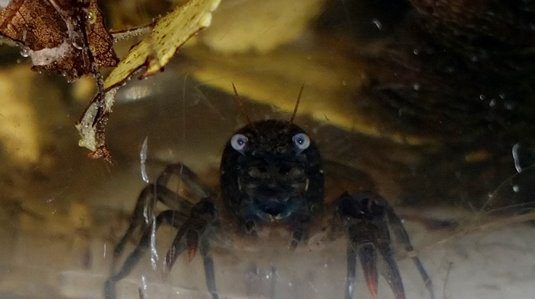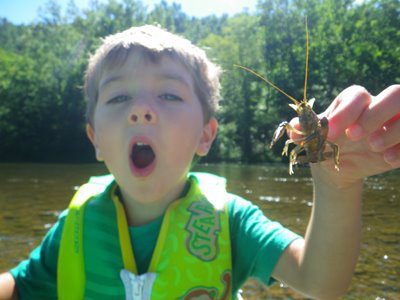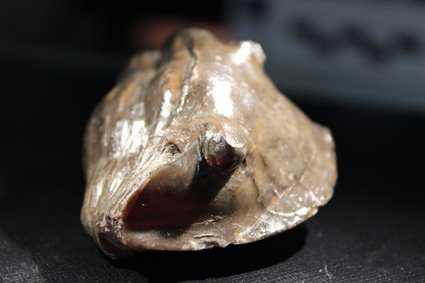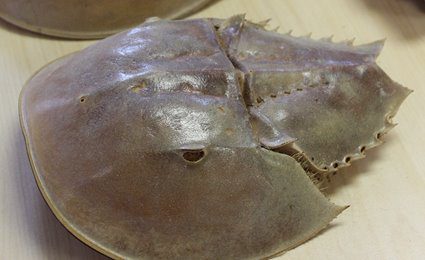If you haven’t heard, a recent article reports that crayfish (superfamily Astacoidea) experience stress and anxiety similarly to humans.
The neurotransmitter that triggers an anxious emotional state in humans is also found in the brains of crayfish that exhibit anxious behavior (i.e. hiding), and the same drug used to treat human anxiety also caused crayfishes to become more exploratory (i.e., hide less).

Crayfish, Crawdad, Crawfish, Mudbug: whatever your name for this animal, they’re a freshwater version of the familiar marine lobster.
Ohio is home to 21 species of crayfish. In addition to being used for bait, crayfish are also eaten by humans. Once considered “a poor person’s food”, crayfish are now served in upscale restaurants, depending on the season and your locality. They are primarily an aquatic animal but some species create burrows to access muddy terrestrial habitats. These burrows look like mini volcanoes and can be easily seen at Wahkeena Nature Preserve along the trail sections that pass close by the pond. Crayfish are more active at night, but may be found hiding under logs and rocks in ponds and streams during the day.

Found one! Photo credit: Annie Lindsay.
The thought of arthropod anxiety intrigued me, so I trawled the internet and discovered Gourmet Magazines Consider the Lobster, a hefty article describing not only the lobster’s role in our economy and how its been perceived through the ages, but also its physiology and ecology. This topical quote is on page 5:
This author posits that the lobster is capable of perceiving something akin to pain, or at the very least a strong preference to not be in boiling water. Boiling alive an organism that can exhibit a preference raises some interesting ethical questions.
Some argue that things lacking an internal skeleton are too primitive to possess the neurological hardware required to feel pain, much less anxiety, but the crayfish study might bring some pause to that argument. Moreover, labeling organisms with value-laden terms like primitive (=not evolved) or advanced (=evolved) is erroneous, or misleading at best.
Take, for example, the humble horseshoe crab. These ridiculously adorable arthropods are not a crab but a chelicerate, sharing a common ancestor with today’s scorpions and spiders.
Often touted as a living fossil, we may never know if their ancestors had similar physiologies, but their body plan has endured 445 million years and five mass extinctions with relatively little change. That’s almost half a billion years, about 10% of Earths history, or nearly 50% of the history of multicellular life!
Their degree of relatedness is contested, but it’s fairly certain that trilobites and horseshoe crabs were close cousins. Although horseshoe crab fossils are not as numerous and not quite as old, they overlap with the trilobites by one or two hundred million years, so it’s possible that they trundled alongside each other in the same shallow seas.
The trilobites were the most numerous and diverse life form on Earth throughout most of the Paleozoic era. Trilobite species numbered in the several tens of thousands, ranged in size from 1 millimeter to over a meter long, and some possessed improbably ornate and complex spines, antennae and prominences. How cool would it be to see one of these fascinating animals alive? But despite their incredible diversity and persistence over 300 million years of geologic time, after a slow decline in diversity and abundance in the fossil record they finally went extinct (along with over 95% of all other sea life) during the Permian-Triassic extinction 251 million years ago.

The state fossil of Ohio is the Isotelus trilobite.
But the horseshoe crab did not. Trees evolved and colonized the land; mountain ranges rose and eroded into dust; whole orders of animals evolved and died out; temperatures soared and plummeted; glaciers repeatedly scoured the land; continents separated and collided and separated again, and not long ago human ancestors walked upright; but the horseshoe crab remained. The ancestral characteristics its retained have made it one of the most enduring and successful life forms to have ever lived. Perhaps we need only look at the horseshoe crab to get a glimpse into trilobite life.
Today, there are only four species of horseshoe crab in existence. In the United States the Atlantic Horseshoe Crab (Limulus polyphemus) is used in biomedical research. The horseshoe crab does not have an immune system like ours; its blue blood coagulates when it encounters endotoxins released by foreign bodies, thus trapping invasive organisms inside a clot. This clotting property makes it very valuable for testing vaccines and medicines for bacterial contamination. Once nearly decimated for fertilizer and fish bait, the horseshoe crab is now worth much more alive than dead. A single liter of copper-based horseshoe crab blood is valued at $15,000 a quart.

The shell of a modern horseshoe crab.
Although the blood collection is touted as non-lethal, one study indicates that up to 18% of crabs die after having their blood drawn. The blood drawing also appears to impair female mobility and feeding rates, which affects their reproductive output; this in turn may contribute to recent population declines. The Atlantic Horseshoe Crab (Limulus polyphemus) is listed as “near threatened” on the IUCN Red List.
Humans are not the only animals that benefit from horseshoe crabs. Their eggs are a vital source of fat and protein for many shorebird species, such as the Red Knot, which time their spring migration to match the seasonal egg-laying of these arthropods. A Red Knot’s migration can be up to an 18,000 mile round trip! Without this food source, the shorebirds can run out of energy and die without reaching their breeding grounds. Because of this, the North American subspecies of Red Knot has been proposed for “threatened” status under the Endangered Species Act.
The unassuming horseshoe crab, despite its inoffensive habits, retiring nature, and relatively low populations, nevertheless has a disproportionately large impact on the ecosystem. I wonder how the loss of the trilobite influenced how our biome functions today.
Arthropods like the crayfish and horseshoe crab went down a vastly different evolutionary path than ours. Our common ancestor lived over 600 million years ago–so long ago that we’re not really sure what it looked like or how it lived. One side effect of this evolutionary happenstance is that we have a different number of limbs–probably the main reason why many people find them unsavory or even detestable–the crime of having “too many legs”.
But evolution does not find the best solution to a problem; it finds one solution. Completely independently of each other, chordates and arthropods both developed supportive tissue (i.e. skeletons), complex eyes, sophisticated sensory systems, intricate social behaviors and even flight; yet arthropods make up over 80% of all animal species. Chordates like us make up only 3-5%. Are arthropods primitive? You tell me.
They may not be composing symphonies or doing your taxes, but they might be feeling a little nervous when you walk by.